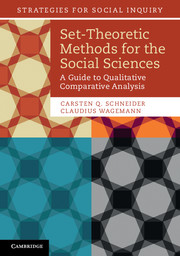Book contents
- Frontmatter
- Contents
- Figures
- Tables
- Acknowledgements
- Introduction
- Part I Set-theoretic methods: the basics
- Part II Neat formal logic meets noisy social science data
- Part III Potential pitfalls and suggestions for solutions
- Part IV Variants of QCA as a technique meet QCA as an approach
- Glossary
- Bibliography
- Index
Introduction
Published online by Cambridge University Press: 05 November 2012
- Frontmatter
- Contents
- Figures
- Tables
- Acknowledgements
- Introduction
- Part I Set-theoretic methods: the basics
- Part II Neat formal logic meets noisy social science data
- Part III Potential pitfalls and suggestions for solutions
- Part IV Variants of QCA as a technique meet QCA as an approach
- Glossary
- Bibliography
- Index
Summary
Set-theoretic approaches in the social sciences
Arguments about set relations are pervasive in the social sciences, but this is not always obvious. Take, for example, Brady’s (2010) intriguing deconstruction of the widely debated claim that, in the 2000 US Presidential Election, George W. Bush lost about 10,000 votes because Al Gore had been declared the winner before the closure of the polling stations in those western counties of Florida that are on Central Standard Time (i.e., the Panhandle). This claim is made by Lott (2000), who arrived at this inference by estimating a “‘difference-in-differences’ form of regression analysis, based on data-set observations” (Brady 2010: 238). Using causal-process observations, Brady cogently shows that this inference is “highly implausible” (241) and that, instead of 10,000 lost voters, a more adequate estimate would be a maximum of 224 or, even more realistically, 28 to 56 voters (NB: total voters, not percentage!). Brady successfully frames his debate of Lott as an argument in favor of causal-process observations – “diagnostic ‘nuggets’ of data that make a strong contribution to causal inference” (Brady 2010: 237).
Brady ’s argument is set-theoretic in nature (Goertz and Mahoney 2012 ). In essence, he claims that the set of voters not voting for Bush due to the premature announcement of Gore as the winner (Y) can only be very small because membership in this set requires simultaneous membership in several other sets. Such allegedly lost Bush voters must, of course, also be members of the set of registered voters in the Panhandle counties (P), who are also members of the set of voters who had not yet voted (V), and the set of voters who had received the news through the media (M).
- Type
- Chapter
- Information
- Set-Theoretic Methods for the Social SciencesA Guide to Qualitative Comparative Analysis, pp. 1 - 20Publisher: Cambridge University PressPrint publication year: 2012
- 2
- Cited by

